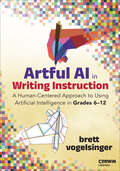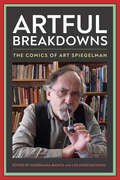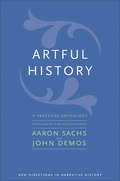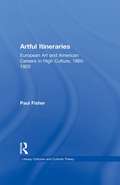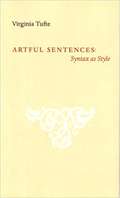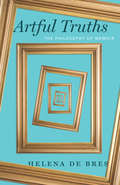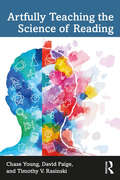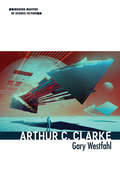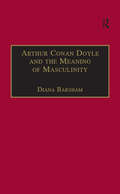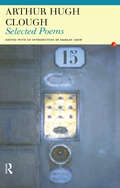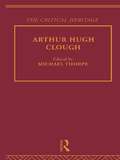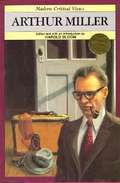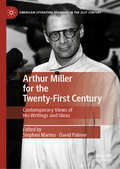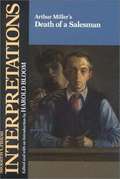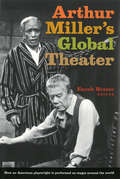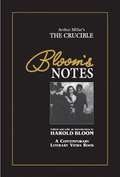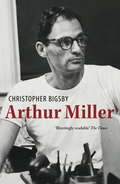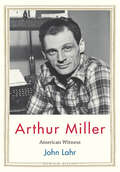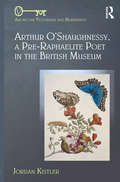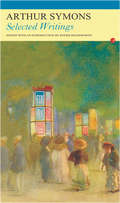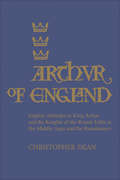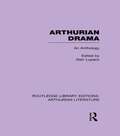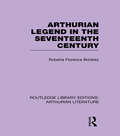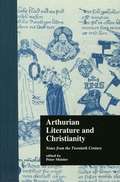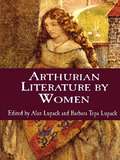- Table View
- List View
Artful AI in Writing Instruction: A Human-Centered Approach to Using Artificial Intelligence in Grades 6–12
by Brett VogelsingerDiscover strategies to use AI thoughtfully in every stage of the writing process—without compromising creativity or critical thinking Feeling conflicted about integrating artificial intelligence (AI) into your writing instruction? You’re not alone. In a world where AI-generated text can seem like a writing teacher’s enemy, incorporating it into writing instruction may feel like an act of betrayal. The advent of generative AI might feel like "one more thing" eroding students’ capacity for deep thinking. Artful AI in Writing Instruction offers strategies and lessons for middle and high school teachers to harness AI in a positive way, integrating it into the writing process and evaluating the ethics of its usage. Written by a full-time high school teacher, Brett Vogelsinger, the book focuses on evergreen principles and ideas rather than specific AI tools, providing concrete steps and lessons that teachers can implement without being technology experts. Acknowledging the varying perspectives of teachers on AI in writing instruction, from skepticism to enthusiasm, Brett offers a human-centered, considered, and ethical approach to using generative AI in the classroom. Demonstrating how AI can be used artfully in the classroom to enhance students′ writing skills and foster reflection on the writing process, this book Provides standards-aligned lessons that detail how AI can support instruction and assist students at each step of the writing process from prewriting through publishing Emphasizes how to use AI tools to mine authentic human ideas and enhance creativity in the classroom Aims to help teachers build a healthy relationship with AI technology and use it thoughtfully in their writing instruction Includes chapter features such as quotes from esteemed writers, real teacher and student voices, cautionary notes, and "Bot Thoughts" entries of example AI output Artful AI in Writing Instruction is a book that explores technology with humility, critiquing its drawbacks and harnessing its strengths, in an effort to guide teachers on how to use AI to help students grow their thinking and their skills rather than bypassing that development.
Artful Breakdowns: The Comics of Art Spiegelman (Tom Inge Series on Comics Artists)
by Georgiana Banita and Lee KonstantinouContributions by Georgiana Banita, Colin Beineke, Harriet Earle, Ariela Freedman, Liza Futerman, Shawn Gilmore, Sarah Hamblin, Cara Koehler, Lee Konstantinou, Patrick Lawrence, Philip Smith, and Kent Worcester A carefully curated, wide-ranging edited volume tracing Art Spiegelman’s exceptional trajectory from underground rebellion to mainstream success, Artful Breakdowns: The Comics of Art Spiegelman reveals his key role in the rise of comics as an art form and of the cartoonist as artist. The collection grapples with Spiegelman’s astonishing versatility, from his irreverent underground strips, influential avant-garde magazine RAW, the expressionist style of the comics classic Maus, the illustrations to the Jazz Age poem “The Wild Party,” and his response to the September 11 terrorist attacks to his iconic cover art for the New Yorker, his children’s books, and various cross-media collaborations. The twelve chapters cut across Spiegelman’s career to document continuities and ruptures that the intense focus on Maus has obscured, yielding an array of original readings. Spiegelman’s predilection for collage, improvisation, and the potent protest of silence shows his allegiance to modernist art. His cultural critique and anticapitalist, antimilitary positions shed light on his vocal public persona, while his deft intertextual strategies of mixing media archives, from comics to photography and film, amplify the poignance of his works. Developing new approaches to Spiegelman’s comics—such as the publication history of Maus, the history of immigration and xenophobia, and the cartoonist’s elevation of children’s comics—the collection leaves no doubt that despite the accolades his accessible comics have garnered, we have yet to grasp the full range of Spiegelman’s achievements in the realm of comics and beyond.
Artful History: A Practical Anthology (New Directions in Narrative History)
by John Demos Aaron SachsA collection of memorable, stirring, and eloquent historical essays, designed to help any historian write more artfully Is there any reason that serious historical scholarship cannot receive literary expression? Isn&’t it possible that the most committed empiricists and postmodernists might both achieve better results by thinking of writing as a craft, rather than just a means of packaging research? This book compiles some of the most compelling efforts to make history writing eloquent, stirring, and memorable, in the realms of both practice and theory. The authors included here prove the great potential of approaching the writing of history as a literary art, even as they retain a commitment to rigorous scholarship. The collection shows how historians can aspire to find a form that matches and enhances their substance, nudging readers toward what historian John Clive called the &“spell that lingers in the memory and is conducive not just to reading but to rereading.&” With selections from: Jonathan Spence, Simon Schama, Saidiya Hartman, Wendy Warren, Jill Lepore, Louis Masur, Jane Kamensky, and John Demos, among others.
Artful Itineraries: European Art and American Careers in High Culture, 1865-1920 (Literary Criticism and Cultural Theory)
by Paul FisherFirst Published in 2000. Routledge is an imprint of Taylor & Francis, an informa company.
Artful Sentences: Syntax as Style
by Virginia TufteIn Artful Sentences: Syntax as Style,Virginia Tufte shows how standard sentence patterns and forms contribute to meaning and art in more than a thousand wonderful sentences from the twentieth and twenty-first centuries. The book has special interest for aspiring writers, students of literature and language, and anyone who finds joy in reading and writing.
Artful Truths: The Philosophy of Memoir
by Helena de BresOffers a philosophical perspective on the nature and value of writing a memoir. Artful Truths offers a concise guide to the fundamental philosophical questions that arise when writing a literary work about your own life. Bringing a philosopher’s perspective to a general audience, Helena de Bres addresses what a memoir is, how the genre relates to fiction, memoirists’ responsibilities to their readers and subjects, and the question of why to write a memoir at all. Along the way, she delves into a wide range of philosophical issues, including the nature of the self, the limits of knowledge, the idea of truth, the obligations of friendship, the relationship between morality and art, and the question of what makes a life meaningful. Written in a clear and conversational style, it offers a resource for those who write, teach, and study memoirs, as well as those who love to read them. With a combination of literary and philosophical knowledge, de Bres takes the many challenges directed at memoirists seriously, while ultimately standing in defense of a genre that, for all its perplexities—and maybe partly because of them—continually proves to be both beloved and valuable.
Artfully Teaching the Science of Reading
by Timothy V. Rasinski Chase Young David PaigeThis inviting book is a bridge between two major strands of reading instruction that are often held in opposition: the science of reading and artful approaches to teaching reading. Although the current climate of literacy instruction positions these approaches as diametrically opposed, the authors Young, Paige, and Rasinski describe how teachers can use the science of reading to engage students in artful, engaging, and authentic instruction. The authors reveal how effective teaching is a dynamic process that requires agency and creativity and show how teachers make artful shifts based on the needs of students in specific contexts. Chapters include a range of examples and explanations of how artful teaching is integrated into reading instruction and how it can increase students’ motivation and positive attitudes toward reading. The concise and practical chapters cover key topics, including phonemic awareness, reading fluency, vocabulary, assessment, home and family reading, and more. This essential road map for all pre-service and in-service reading teachers restores the importance of teacher agency, supports the critical understanding of reading research, and allows teachers to use their knowledge, experience, and creative approaches in the classroom. This is the definitive guide to teaching reading as both an art and a science.
Arthur C. Clarke (Modern Masters of Science Fiction #36)
by Gary WestfahlAlready renowned for his science fiction and scientific nonfiction, Arthur C. Clarke became the world's most famous science fiction writer after the success of 2001: A Space Odyssey. He then produced novels like Rendezvous with Rama and The Fountains of Paradise that many regard as his finest works. Gary Westfahl closely examines Clarke's remarkable career, ranging from his forgotten juvenilia to the passages he completed for a final novel, The Last Theorem. As Westfahl explains, Clarke's science fiction offered original perspectives on subjects like new inventions, space travel, humanity's destiny, alien encounters, the undersea world, and religion. While not inclined to mysticism, Clarke necessarily employed mystical language to describe the fantastic achievements of advanced aliens and future humans. Westfahl also contradicts the common perception that Clarke's characters were bland and underdeveloped, arguing that these reticent, solitary individuals, who avoid conventional relationships, represent his most significant prediction of the future, as they embody the increasingly common lifestyle of people in the twenty-first century.
Arthur Conan Doyle and the Meaning of Masculinity (The Nineteenth Century Series)
by Diana BarshamA valued icon of British manhood, Sir Arthur Conan Doyle has been the subject of numerous biographies since his death in 1930. All his biographers have drawn heavily on his own autobiography, Memories & Adventures, a collection of stories and anecdotes themed on the subject of masculinity and its representation. Diana Barsham discusses Doyle's career in the context of that nineteenth-century biographical tradition which Dr Watson so successfully appropriated. It explores Doyle's determination to become a great name in the culture of his day and the strains on his identity arising from this project. A Scotsman with an alcoholic, Irish, fairy-painting father, Doyle offered himself and his writings as a model of British manhood during the greatest crisis of British history. Doyle was committed to finding solutions to some of the most difficult cultural problematics of late Victorian masculinity. As novelist, war correspondent, historian, legal campaigner, propagandist and religious leader, he used his fame as the creator of Sherlock Holmes to refigure the spirit of British Imperialism. This original and thought-provoking study offers a revision of the Doyle myth. It presents his career as a series of dialoguic contestations with writers like Thomas Hardy and Winston Churchill to define the masculine presence in British culture. In his spiritualist campaign, Doyle took on the figure of St Paul in an attempt to create a new religious culture for a Socialist age.
Arthur Hugh Clough: Selected Poems (G - Reference, Information And Interdisciplinary Subjects Ser.)
by Arthur Hugh CloughThis book presents a selection of the full range of Arthur Hugh Clough's poetry, which explores the tensions of a time of radical changes in the religious, political, and literary landscape. It also includes a detailed introduction and annotations by Shirley Chew.
Arthur Hugh Clough: The Critical Heritage (Critical Heritage Ser.)
by Michael ThorpeThe Critical Heritage gathers together a large body of critical sources on major figures in literature. Each volume presents contemporary responses to a writer's work, enabling students and researchers to read the material themselves.
Arthur Miller (Modern Critical Views)
by Harold BloomSelected essays about the author and his works.
Arthur Miller for the Twenty-First Century: Contemporary Views of His Writings and Ideas (American Literature Readings in the 21st Century)
by Stephen Marino David PalmerArthur Miller for the Twenty-First Century: Contemporary Views of His Writings and Ideas brings together both established Miller experts and emerging commentators to investigate the sources of his ongoing resonance with audiences and his place in world theatre. The collection begins by exploring Miller in the context of 20th-century American drama. Chapters discuss Miller and Eugene O’Neill, Tennessee Williams, Edward Albee, David Mamet, and Sam Shepard, as well as thematic relationships between Miller’s ideas and the explosion of significant women and African American dramatists since the 1970s. Other essays focus more directly on interpretations of Miller’s individual works, not only plays but also essays and fiction, including a discussion of Death of a Salesman in China. The volume concludes by considering Miller and current cultural issues: his work for human rights, his depiction of American ideals of masculinity, and his anticipation of contemporary posthumanism.
Arthur Miller's Death of a Salesman (Modern Critical Interpretations)
by Harold BloomSelected essays.
Arthur Miller's Global Theater
by Enoch BraterNo American playwright is more revered on the international stage than Arthur Miller. In Arthur Miller’s Global Theater—a fascinating collection of new essays by leading international critics and scholars—readers learn how and why audiences around the world have responded to the work of the late theatrical icon. With perspectives from diverse corners of the globe, from Israel to Japan to South Africa, this groundbreaking volume explores the challenges of translating one of the most American of American playwrights and details how disparate nations have adapted meaning in Miller’s most celebrated dramas. An original and engaging collection that will appeal to theater aficionados, scholars, students, and all those interested in Miller and his remarkable oeuvre, Arthur Miller’s Global Theater illustrates how dramas such as Death of a Salesman, The Crucible, and A View from the Bridge developed a vigorous dialogue with new audiences when they crossed linguistic and national borders. In these times when problems of censorship, repressive regimes, and international discord are increasingly in the news, Arthur Miller’s voice has never been more necessary as it continues to be heard and celebrated around the world.
Arthur Miller: 1962-2005
by Christopher BigsbyAuthorised biography of one of the greatest of modern playwrights, Arthur Miller (1915-2005). This is the long-awaited authorised biography of one of the twentieth century's (and America's) greatest playwrights, whose accomplishment bears comparison with Eugene O'Neill and Tennessee Williams. A post-war decade of work earned him international critical and popular acclaim - 'All My Sons' (1947), 'Death of a Salesman' (1949), 'The Crucible' (1953) and 'A View from the Bridge' (1955) are modern classics of the theatre. Miller was born in 1915 and wrote during a fascinating time in American history. He matured during the Great Depression and like many found hope for the beleaguered common man in Communism in a country that was essentially deeply conservative. The Great Depression was a period of deprivation for many that left a mark upon the national psyche comparable to the mark the family feud of the American Civil War left upon the nation. The chill left by the shadow of sudden collapse of banks and businesses and farms was felt for many years after the US had become prosperous. The Second World War elevated the common man to war hero and it was not until Japan was defeated and the Cold War began that the ugly elements of American conservatism would freely persecute writers and artists who had embraced Communism, no matter if it had only been flirtatiously. Miller was among them. His refusal to name names and to co-operate with the notorious House of Un-American Activities gave him a heroic role to play. In that same year, 1956, Arthur Miller momentously got married a second time - to Marilyn Monroe. The biography ends shortly after her tragic death in 1962, and eloquently shows how their relationship informed Miller's great plays.
Arthur Miller: American Witness (Jewish Lives)
by John LahrA great theater critic brings twentieth-century playwright Arthur Miller&’s dramatic story to life with bold and revealing new insights &“New Yorker critic Lahr shines in this searching account of the life of playwright Arthur Miller. . . . It&’s a great introduction to a giant of American letters.&”—Publishers Weekly Distinguished theater critic John Lahr brings unique perspective to the life of Arthur Miller (1915–2005), the playwright who almost single-handedly propelled twentieth-century American theater into a new level of cultural sophistication. Organized around the fault lines of Miller&’s life—his family, the Great Depression, the rise of fascism, Elia Kazan and the House Committee on Un-American Activities, Marilyn Monroe, Vietnam, and the rise and fall of Miller&’s role as a public intellectual—this book demonstrates the synergy between Arthur Miller&’s psychology and his plays. Concentrating largely on Miller&’s most prolific decades of the 1940s, 1950s, and 1960s, Lahr probes Miller&’s early playwriting failures; his work writing radio plays during World War II after being rejected for military service; his only novel, Focus; and his succession of award-winning and canonical plays that include All My Sons, Death of a Salesman, and The Crucible, providing an original interpretation of Miller&’s work and his personality.
Arthur O'Shaughnessy, A Pre-Raphaelite Poet in the British Museum (Among the Victorians and Modernists)
by Jordan KistlerArthur O'Shaughnessy's career as a natural historian in the British Museum, and his consequent preoccupation with the role of work in his life, provides the context with which to reexamine his contributions to Victorian poetry. O'Shaughnessy's engagement with aestheticism, socialism, and Darwinian theory can be traced to his career as a Junior Assistant at the British Museum, and his perception of the burden of having to earn a living outside of art. Making use of extensive archival research, Jordan Kistler demonstrates that far from being merely a minor poet, O'Shaughnessy was at the forefront of later Victorian avant-garde poetry. Her analyses of published and unpublished writings, including correspondence, poetic manuscripts, and scientific notebooks, demonstrate O'Shaughnessy's importance to the cultural milieu of the 1870s, particularly his contributions to English aestheticism, his role in the importation of decadence from France, and his unique position within contemporary debates on science and literature.
Arthur Symons: Selected Writings (Fyfield Bks.)
by Roger HoldsworthFirst published in 2004. Routledge is an imprint of Taylor & Francis, an informa company.
Arthur of England: English Attitudes to King Arthur and the Knights of the Round Table in the Middle Ages and the Renaissance
by Christopher DeanToday, popular imagination peoples the Middle Ages with damsels in distress and knights riding to their rescue. Of such knights, King Arthur and his companions are the most celebrated. It is certainly true that this is the time when the Arthurian story took shape and Arthurian literature flourished, and that most medieval historians included him in their histories of Britain, though some did so with a considerable degree of scepticism. But how widely was this literature known in its own day? How much credence did people generally place in this king who supposedly once ruled England? To answer these questions, Christopher Dean looks at medieval and Renaissance Arthurian literature in detail, and also examines contemporary chronicles and histories, chivalric theory and practice, popular myths and legends, folk-lore and place-names. The result is to show dramatically that Arthur was not at all as well known as popular belief today fancies. As a historical figure he was early discredited; had it not been for his artificial revival by the Tudor monarchy and the furor caused by the attack upon him by the 'foreigner' Polydore Vergil, which incensed many patriotic Englishmen, his credibility might have disappeared much sooner than it did. Except for Malory's work, medieval Arthurian literature, which often exists in no more than single manuscripts, did not have large audiences. And after 1500, only Edmund Spenser and Thomas Hughes attempted to write seriously on Arthurian themes. Among the ordinary citizens of England, Arthur was hardly known at all, any popular knowledge of him being almost entirely restricted to Wales, Devon, and Cornwall. Elsewhere in Britain the much more familiar figure was Robin Hood. For all the strength of the Arthurian legend as the ultimate medieval knight, he is essentially a modern hero.
Arthurian Drama: An Anthology (Routledge Library Editions: Arthurian Literature)
by Alan LupackThis anthology reproduces six plays based on stories of King Arthur from a variety of periods. Originally published in 1991, it offers a comprehensive discussion of Arthurian Drama in introduction and also provides an appendix listing printed scripts in English that address Arthurian legend.
Arthurian Legend in the Seventeenth Century (Routledge Library Editions: Arthurian Literature)
by Roberta Florence BrinkleyThe study of the Arthurian legend in the 1600s has revealed almost no romance; the stories are more about the truth of Arthur’s existence and his exploits, with influence due to political bearing of the royalty versus parliament at the time. This fascinating study elucidates the differences between the stories of the seventeenth century and those more well-known now and looks at the development of the literature in line with the political climate and its links with Arthurian prophecy and lineage. Originally published 1932 and again in 1967.
Arthurian Literature and Christianity: Notes from the Twentieth Century (Garland Library of Medieval Literature #Vol. 2134)
by Peter MeisterIntended as "the other bookend" to Jessie Weston's work some eighty years earlier, this essay collection provides a careful overview of recent scholarship on possible overlap between Arthurian literature and Christianity. From Ritual to romance and Notes, taken together, bracket contemporary inquiry into the relationship (if any) between Jesus and Arthur. T.S. Eliot's "The Waste Land" is here regarded as one strand joining this matter to many a recent literary riddle (such as the meaning of the term "postmodernism"). Without reprinting work readily available elsewhere and no longer subject to revision through dialogue with fellow contributors, Notes attempts to do justice to all sides in twentieth century exploration of christianity's contribution to an art form which is also grounded in early European polytheism ("paganism").
Arthurian Literature by Women: An Anthology
by Alan Lupack Barbara T. LupackArthurian Literature by Women: An Anthology is a collection of Arthurian poems, stories, and plays by women, from Marie de France to the present, all of which are either significant examples of Arthurian literature or innovative interpretations of Arthurian tradition. Rather than reproducing brief selections from contemporary novels that are readily available, the volume collects and reprints works that have generally been overlooked by students of the Arthurian legend. The volume will be especially interesting to those studying or teaching Women and the Arthurian Legend or any other aspect of myth, fantasy, popular literature, or women's studies.
